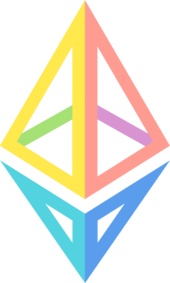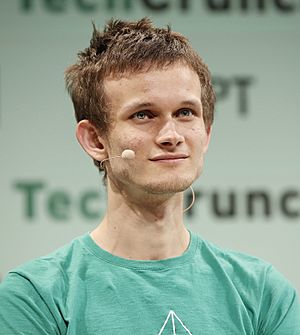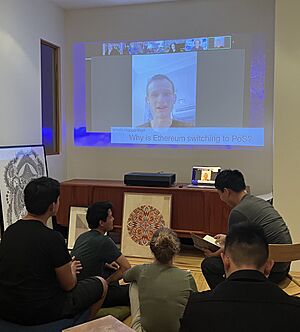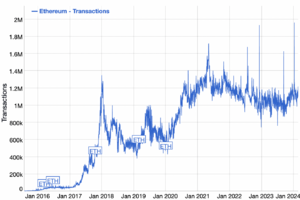Ethereum facts for kids

Logo
|
|
| Original author(s) | Vitalik Buterin Gavin Wood |
|---|---|
| Initial release | 30 July 2015 |
| Stable release | 1.12.2 / 13 August 2023 |
| Development status | Active |
| Software used | EVM 1 Bytecode |
| Written in | Go, Rust, C#, C++, Java, Python, Nim, TypeScript |
| Operating system | Cross-platform |
| Platform | x86-64, ARM |
| Available in | Multilingual, but primarily English |
| Type | Distributed computing |
| License | Open-source licenses |
| Active hosts | ~8,600 nodes (6 June 2023) |
Ethereum is like a giant, shared computer that anyone can use. It's a decentralized (meaning no single person or company controls it) blockchain that lets people create special computer programs called smart contracts. These contracts run automatically when certain conditions are met.
The main digital money used on Ethereum is called Ether (abbreviation: ETH). After bitcoin, Ether is the second most valuable cryptocurrency in the world. Ethereum is also open-source software, which means its code is public and anyone can see or use it.
Ethereum was first thought up in 2013 by a programmer named Vitalik Buterin. Other important people who helped create it include Gavin Wood, Charles Hoskinson, Anthony Di Iorio, and Joseph Lubin. Work on Ethereum started in 2014, and it was paid for by people donating money online (this is called crowdfunding). The network officially started on July 30, 2015.
Ethereum lets anyone build and use decentralized applications (dApps). These are apps that don't rely on a central company or server. For example, Decentralized finance (DeFi) apps offer financial tools without needing banks or brokers. This means you can borrow or lend digital money and earn interest. Ethereum also lets users create different kinds of digital tokens, like non-fungible tokens (NFTs), which are unique digital items.
On September 15, 2022, Ethereum made a big change called "The Merge." It switched how it secures its network from "proof-of-work" to "proof-of-stake." This change made Ethereum use over 99% less energy, which is much better for the environment.
Contents
History of Ethereum
How Ethereum Started (2013–2014)
The idea for Ethereum was first written down in late 2013 by Vitalik Buterin. He was a programmer and also helped start Bitcoin Magazine. Buterin wrote a "white paper" (a detailed report) about how to build decentralized applications. He believed that blockchain technology could be used for more than just money. He wanted a stronger programming language for apps that could link real-world things, like stocks or property, to the blockchain.
In January 2014, Ethereum was announced at a big Bitcoin conference in Miami. Buterin and other founders, including Gavin Wood, Charles Hoskinson, and Anthony Di Iorio, worked together to plan what Ethereum would become. Later, in Switzerland, Buterin decided the project would be a non-profit. Charles Hoskinson then left to start his own blockchain company, IOHK, which created Cardano.
Ethereum has many founders. Vitalik Buterin picked the name "Ethereum" from a list of science fiction elements. He liked that it sounded nice and included "ether," which refers to an invisible substance that was once thought to fill the universe. He wanted his platform to be the invisible foundation for applications.
Building the Software (2014)
The actual work of building Ethereum's software began in early 2014. A Swiss company called Ethereum Switzerland GmbH (EthSuisse) started the development.
Gavin Wood, who was the chief technology officer, wrote the "Ethereum Yellow Paper." This paper explained how the Ethereum Virtual Machine (EVM) would work. The EVM is like the engine that runs all the smart contracts on Ethereum. Later, a non-profit group called the Ethereum Foundation was created in Switzerland.
To pay for the development, they held an online public sale from July to August 2014. People could buy Ether tokens using bitcoin. Even though many praised Ethereum's new ideas, some worried about its security and how well it could handle many users.
The Foundation supported several teams in different cities. These teams built different versions of the Ethereum software. This was done so that if one version had a problem, the others could be used for comparison.
Launch and the DAO Event (2014–2016)
Before its official launch, the Ethereum Foundation created several test versions of Ethereum. "Olympic" was the last test version. Users were even given 25,000 Ether as a reward for testing the network and finding bugs.
On July 30, 2015, "Frontier" marked the official start of the Ethereum platform. This is when the first block of transactions, called the "genesis block," was created.
Since then, Ethereum has had several planned upgrades to improve how it works. These upgrades are done through a "hard fork," which means a major change to the network's rules.
In 2016, a decentralized autonomous organization (DAO) called The DAO was created on Ethereum. It was a set of smart contracts that raised a huge amount of money, about $150 million, from people online. However, in June 2016, about $50 million worth of DAO tokens were stolen by a hacker. This led to a big discussion: should Ethereum change its history to get the stolen money back?
The community decided to do a "hard fork" to reverse the theft. This split the network into two separate blockchains:
- Ethereum: The new chain where the theft was undone.
- Ethereum Classic: The original chain where the theft remained.
New Developments and Milestones (2017–Present)
In March 2017, many blockchain companies and large businesses like Fortune 500 companies formed the Enterprise Ethereum Alliance (EEA). This group wanted to explore how businesses could use Ethereum. By May 2017, it had 116 members, including Microsoft, Intel, and JPMorgan Chase. By July 2017, there were over 150 members, including MasterCard and Cisco Systems.
CryptoKitties and the ERC-721 NFT Standard
In 2017, a game called CryptoKitties became very popular on Ethereum. It was a blockchain game where players collected digital cat artwork as NFTs. This game brought a lot of attention to Ethereum. However, it also showed that Ethereum needed to improve how many transactions it could handle, as the game used a lot of the network's capacity.
In January 2018, a new standard for NFTs on Ethereum was created called ERC-721: Non-Fungible Token Standard. This standard made it easier to create and trade unique digital items. It helped Ethereum become a central part of the multi-billion dollar digital collectibles market.
Other Important Changes
By January 2018, Ether was the second-largest cryptocurrency by value, right after bitcoin. It has kept this position.
In March 2021, Visa Inc. announced it started using Ethereum to handle some of its transactions. In April 2021, big banks like JP Morgan Chase and UBS invested $65 million into ConsenSys, a company that builds tools for Ethereum.
Ethereum had two network upgrades in 2021. "Berlin" happened on April 14, 2021. "London" took effect on August 5, 2021. The London upgrade included a change called EIP-1559. This change helped make transaction fees more stable. It also caused a part of the fees to be "burned" (destroyed), which can reduce the total amount of Ether in circulation.
The Merge: From Proof-of-Work to Proof-of-Stake
"The Merge" was a major upgrade that changed how Ethereum secures its network. Before "The Merge," Ethereum used "proof-of-work" (PoW), which required a lot of computing power and energy. After "The Merge," which happened on September 15, 2022, Ethereum switched to "proof-of-stake" (PoS). This new method uses over 99% less energy.
"The Merge" involved three main updates:
- Bellatrix: This updated the "Beacon chain," which is the part of Ethereum that uses proof-of-stake.
- Paris: This was the actual moment on September 15, 2022, when the original Ethereum chain joined with the Beacon chain.
- Shapella (Shanghai-Capella): This update, which happened later, allowed people who had "staked" their Ether to withdraw it.
Updates After The Merge
Dencun
On March 13, 2024, a set of upgrades called "Dencun" (or "Deneb-Cancun") went live. A key part of this was EIP-4844, which introduced "blobs." Blobs are like temporary storage spaces for data. Because this data is only stored for a short time, it's much cheaper to use than regular storage. This helps "Layer 2" networks (which are built on top of Ethereum) to make their transactions much cheaper.
Pectra
The next big update for Ethereum is called "Pectra" (Prague-Electra). It is expected to be launched in mid-2025. This update will bring several improvements. For example, EIP-7251 will allow people to stake more Ether as a validator, up to 2048 ETH. EIP-7702 will also give regular user accounts some features that smart contracts have.
How Ethereum Works
Overview
Ethereum is a peer-to-peer network. This means all the computers in the network talk directly to each other, without a central server. This network keeps a shared database that stores information about all Ethereum accounts and processes changes to them.
About every 12 seconds, a group of new transactions, called a "block," is processed. Each block has a special code (a cryptographic hash) that links it to the block before it. This chain of linked blocks is what we call the blockchain.
Each "node" (a computer participating in the network) connects to a few other nodes. It shares new blocks and unconfirmed transactions with them. This way, information quickly spreads across the entire network. A node's collection of unconfirmed transactions is called its "mempool."
Any node can create its own copy of the entire Ethereum history. It does this by starting from the very first block and running every transaction in the correct order.
To help secure the network, any Ethereum account can "stake" (deposit) 32 or more ETH to become a "validator." Validators are chosen randomly to either propose a new block or confirm existing blocks. If a validator tries to cheat or is inactive, they can lose some of their staked Ether. Validators are rewarded with Ether for doing their job correctly, which encourages them to keep the network running smoothly.
Ether: The Digital Fuel
Ether (ETH) is the digital currency created by the Ethereum network. It's given as a reward to validators for adding new blocks to the blockchain. Ether is measured in tiny units called "wei" (1 Ether equals 1018 wei).
New Ether is created and given to validators who successfully propose or confirm blocks. Also, Ether is the only currency accepted by the network to pay for transaction fees. These fees have two parts:
- Base fee: This part is "burned" (deleted forever), which can help control the total amount of Ether.
- Tip: This part goes to the validator who includes your transaction in a block. A higher tip can make your transaction get processed faster.
These rewards and tips encourage validators to keep the blockchain growing and processing new transactions. So, Ether is essential for the network to work. You can send Ether from one account to another, just like sending money.
People sometimes mistakenly call Ether "Ethereum." Remember, Ethereum is the platform, and Ether is the currency.
Accounts on Ethereum
There are two main types of accounts on Ethereum:
- User accounts: These are controlled by people using special digital keys.
- Contract accounts: These are controlled by smart contract code.
Both types of accounts can hold Ether, send Ether to other accounts, and interact with smart contracts. Each account has a unique address on the blockchain.
Contract accounts are special because they contain computer code (called bytecode) and can store information. When a transaction is sent to a contract, its code runs. This code can read data, send Ether, store information, and even interact with other contracts.
Ethereum Addresses
Ethereum addresses look like a long string of numbers and letters, starting with "0x". For example, 0xb794f5ea0ba39494ce839613fffba74279579268. These addresses are created using a special mathematical process from a public key. Contract addresses follow the same format but are created differently.
The Ethereum Virtual Machine (EVM)
The Ethereum Virtual Machine (EVM) is like the "brain" or "computer" inside Ethereum. It's where all the smart contracts and transactions are actually run. The EVM is designed to work the same way on any computer, no matter its hardware or operating system. This is important because it ensures that every computer in the Ethereum network gets the same result when processing a transaction. This helps the network agree on the correct state of the blockchain.
Gas: The Fuel for Transactions
"Gas" is a special unit used on Ethereum to measure the amount of work needed to perform an operation. Think of it as the "fuel" for transactions. Every action you take on Ethereum, like sending Ether or running a smart contract, costs a certain amount of gas.
When you send a transaction, you set a "gas limit" (the maximum gas you're willing to use) and a "gas price" (how much Ether you'll pay per unit of gas). The total fee is calculated by multiplying the gas used by the gas price.
A part of the gas price, called the "base fee," is "burned" (destroyed). The other part, called the "tip," goes to the validator who includes your transaction in a block. A higher tip can make your transaction get processed faster. If your transaction runs out of gas before it finishes, it will fail, but you still pay for the gas that was used. Gas prices are often shown in "Gwei," which is a very small amount of Ether.
What Ethereum is Used For
The EVM is very powerful and can run almost any computer program. This means Ethereum can be used for many things:
- Creating different kinds of digital tokens (like ERC-20 for regular tokens and ERC-721 for unique NFTs).
- Crowdfunding (raising money from many people online).
- Decentralized finance (DeFi) applications.
- Decentralized exchanges (places to trade digital assets without a central company).
- Decentralized autonomous organizations (DAOs), which are groups run by code.
- Games and prediction markets.
Smart Contract Code
Ethereum's smart contracts are written in special programming languages, like Solidity. These languages are then turned into EVM bytecode (computer instructions) and put onto the Ethereum blockchain. Often, the original code is published online so people can check it and make sure it matches what's on the blockchain.
One challenge with smart contracts on a public blockchain is that if there's a bug or a security problem, everyone can see it. And once a contract is on the blockchain, it's very hard to change quickly. A famous example is the 2016 attack on The DAO, which couldn't be stopped fast enough.
ERC-20 Tokens
The ERC-20 Token Standard is a set of rules for creating "fungible" tokens on Ethereum. "Fungible" means each token is exactly the same as another, like how one dollar bill is the same as any other dollar bill. This standard helps smart contracts manage tokens, allowing them to be transferred, checked for balances, and track their total supply. Many cryptocurrencies have been launched as ERC-20 tokens.
Non-Fungible Tokens (NFTs)
Non-fungible tokens (NFTs) are unique and cannot be divided. Each NFT is one-of-a-kind. Because they are unique, NFTs are used to represent digital collectibles, digital art, virtual land in games, and other special items. ERC-721 is the first official standard for NFTs on Ethereum.
The very first NFT project, called Etheria, was a 3D map of digital land tiles. It was launched in October 2015. In 2021, a digital image with an NFT by an artist named Beeple sold for $69.3 million at Christie's, a famous auction house.
Decentralized Finance (DeFi)
Decentralized finance (DeFi) offers financial tools that operate without banks or governments. These tools let users do things like earn interest on their digital money. DeFi apps are usually accessed through special web browsers or apps like MetaMask, which connect directly to the Ethereum blockchain. Many of these apps can work together to create complex financial services.
Examples of DeFi platforms include MakerDAO and Uniswap. Uniswap is a decentralized exchange where people can trade tokens on Ethereum. In 2020, the amount of money in Uniswap grew from $20 million to $2.9 billion. By October 2020, over $11 billion was invested in various DeFi projects.
Enterprise Software
Many large companies have tested Ethereum-based software and networks for their own uses. These include Microsoft, IBM, JPMorgan Chase, Deloitte, and Visa.
Permissioned Blockchains
Some companies are also using "permissioned blockchain" versions of Ethereum. These are blockchains where only certain people or organizations are allowed to participate. For example, in 2017, JPMorgan Chase suggested creating "Quorum," a private version of Ethereum, for their own digital currency called JPM Coin. This allows them to control who can see transactions while still using blockchain technology.
Performance of Ethereum
As of March 2025, Ethereum can theoretically handle up to 142 transactions per second (TPS). However, because smart contracts and batch transactions use more "gas," the average number of transactions per second is usually lower. As of January 2016, Ethereum processed about 25 transactions per second, and this number didn't change much after the move to proof-of-stake. In comparison, the Visa payment system can process 45,000 payments per second. This difference has led some people to wonder how well Ethereum can handle a very large number of users.
Ethereum's blockchain uses a special data structure called a Merkle–Patricia Tree to store account information. This helps save storage space and makes it easier for "light clients" (nodes that don't store the full blockchain) to sync up. The network has faced issues with congestion, like in 2017 when CryptoKitties became very popular.
Legal Status and Rules
The legal status of Ether (ETH) can be different depending on the country.
In the United States, government regulators have often said that Ether should be treated as a "commodity." This means it's like a raw material or product, similar to gold or oil, and falls under the rules of the Commodity Futures Trading Commission (CFTC). This classification is mainly because Ethereum is decentralized, meaning no single company controls it, unlike a traditional investment security.
From a legal ownership point of view, many places recognize Ether as a type of digital property. This means it can be owned, transferred, and used as collateral, just like other personal belongings. In the United States, new rules in 2022 called the "Uniform Commercial Code" (UCC) added a new category for digital assets like Ether. Under these rules, Ether is classified as a "controllable electronic record," which helps define how it can be used in business.
See also
 In Spanish: Ethereum para niños
In Spanish: Ethereum para niños




